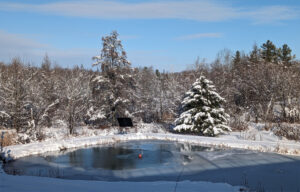Getting your pond ready for winter
Much like owning a garden or a pool, a pond requires some special attention in the fall in order to get ready for winter. There are the obvious tasks like bringing in the dock or taking down the sun tent. What about the less obvious tasks that often get overlooked by pond owners, due to time constraints or simply being unaware of what needs to get done. We have compiled a helpful checklist of pond tasks that you can do over the fall weekends to prepare your pond for winter.
- Apply the final bacteria treatment to your pond before the water temperature drops too low. This will give your pond the last boost it needs to get through the winter, and help reduce the suspended nutrient load many ponds accumulate over the summer and fall. This will prevent later anoxia under the ice cover.
- Study the water flow of your pond. We are big proponents of watershed management, which is a fun and useful tool for any pond owner. All surface water flows somewhere, and you can be sure your pond receives its share of surface water runoff, especially during large storms. What is entering your pond and how is it getting there are two good questions any pond owner can ask themselves. A fun way to find out the answer is to get out the Wellingtons and that bright yellow raincoat, and wander around your pond in a really big rainstorm. Watch what is happening, note where the most surface runoff is entering the pond; is it coming from a road, a manure pile, a roof, a forest? Next, think of several things you can do to prevent fertilizers from entering the pond, or somehow absorb some of the runoff.
- Improve your riparian strip. We recommend that our clients plant aquatic vegetation in the pond and along the shoreline. Plants are wonderful friends to a pond; they filter out excessive nutrients, they offer shoreline stabilization, and they naturalize a pond beautifully to its environment. Through their root systems they also absorb an astounding amount of water, which invariably provides some protection for your pond from contamination of surface runoff. So purchase and plant more shoreline and aquatic plants before the ground freezes. The best part about fall planting is that most aquatic and shoreline plants are on sale now!
- Stop mowing your grass to the water’s edge. Mowing the lawn to the water’s edge is like shaving your dog’s hair before winter. The shoreline grasses provide much needed protection around the pond, not to mention delightful habitat for insects and wildlife. Never ever mow grass closer than a meter to your pond edge. If you stop mowing along the pond edge you will notice a significant difference in the water quality of your pond within a few seasons.
- Check your system’s maintenance. If you aerate your pond, spend some time checking out the aeration system to make sure it is functioning properly before winter starts. What to look for? The sound of the compressor is the same, no seals are cracked, no wires chewed or worn, the system is dry and stored properly. For the tubing, you might want to pull it in, wipe it down and re-install while the water is still warm, but this is optional. These are just common sense maintenance tips that you would do to any outdoor machine. Decide if you will aerate over the winter or stop the aeration when the snow starts. If you plan on skating on your pond we recommend you stop aerating as soon as ice starts to form. Regularly & accurately monitor ice thickness to ensure the ice is safe and thick where you plan to skate.
- If you run the aerator in winter: Purchase and install a Danger Thin Ice sign around your pond if you choose to aerate your pond during the winter. This sign may save someone’s life.
- If you have a floating island: you can either leave it in place, or move it closer to the shore if it will interfere with skating. It will happily freeze and thaw in place and be ready to grow again in the spring. If after several years the dead plant debris seems thick, you can trim it down before winter sets in.